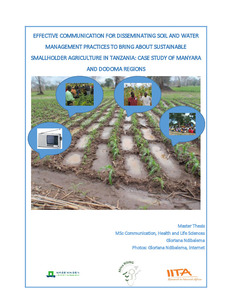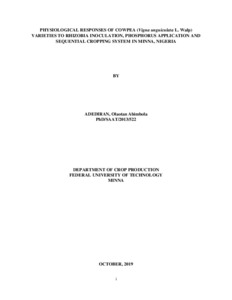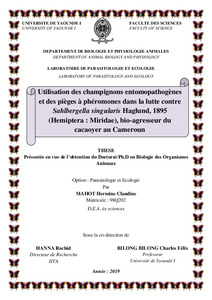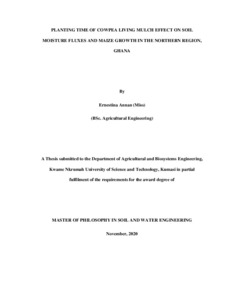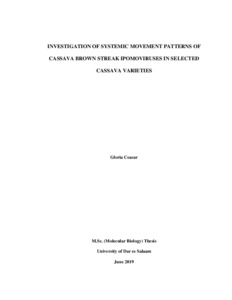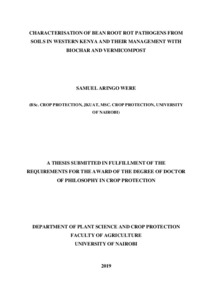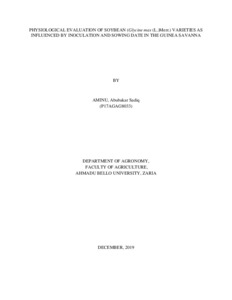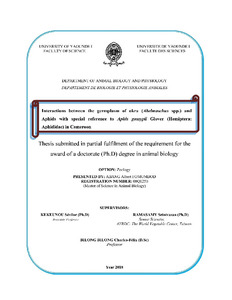Welcome to the International Institute of Tropical Agriculture Research Repository
Theses: Recent submissions
Now showing items 1-20 of 30
-
Growth and nutrient uptake response of cocoa seedlings (Theobroma cacao) to different growth media at the nursery
(University of Energy and Natural Resources Sunyani Ghana, 2024-08)A study was conducted in the nursery house of Mabang Megakarya Selection Programme, a substation of the Cocoa Research Institute of Ghana from April 2022 to September 2022 to determine the growth and nutrient uptake response of cocoa (Theobroma cacao) seedlings to different growth media at the nursery. The treatments comprised three base-materials viz: Topsoil (TS), Rice husk (RH) and Sawdust (SD) amended with three rates of rice husk biochar (RHB) at 75%: 25%, 50%:50% and 25%:75% and two rates ... -
Remote sensing-based land degradation assessment to inform sustainable development goal 15.3: a case study in Ghanaian Savannah, West Africa
(University of Bergen, 2024-06)Land degradation (LD) continues to be a global problem affecting humanity and their livelihoods. Like other African countries, Ghana is one of the countries with elevated levels of LD. However, LD assessments in Ghana have been far and wide and it has not been consistent. There have not been any recent assessments done to inform the SDG indicator 15.3.1 in Ghana. This study therefore focused on the Northern, North East, and Upper East of Ghana and bridged the information gaps on LD. This study was ... -
Genetic diversity in African yam bean [Spenostylis stenocarpa (Hochst ex A. Rich.) Harms] collection
(University of Ibadan, 2023-05)African Yam Bean (AYB) is an underutilized legume with great potential of providing an inexpensive and sustainable solution to malnutrition and food insecurity in Sub-Saharan Africa. However, its genetic variability is not yet fully exploited and documented. To enhance the full exploitation and improvement of the crop, there is a need for knowledge of its genetic diversity. This research was therefore carried out to assess the genetic diversity in AYB germplasm collection using agro-morphological ... -
Evaluation de l'efficacite de l'Aflasafe dans la lutte contre l'Aspergillus spp. synthetisant l'aflatoxine dans les bassins de production de sorgho, de mais et de l'arachide au Mali
(rsity of Bobo Dioulasso, 2023-03)Les aflatoxines sont des mycotoxines dont l’exposition chronique engendre des problèmes graves de santé comme le cancer du foie, le retard de croissance des enfants et l’affaiblissement du système immunitaire. Elles sont couramment rencontrées dans les denrées alimentaires cultivées comme le sorgho (Sorghum bicolor (L.) Moench), le maïs (Zea mays L.) et l’arachide (Arachis hypogaea L.). Aflasafe est un bio pesticide préconisé pour lutter contre les champignons producteurs des aflatoxines. L’objectif ... -
Physicochemical parameters and functional properties of flours from advanced genotypes and improved cassava varieties for industrial applications
(University of Malawi, 2021-08)Cassava has potential for many industrial uses, which provide an opportunity for more rewarding markets. Therefore, significant research on improved varieties, targeting industrial applications, is required as a possible approach to spur improvements in the value chain. In addition, the promotion of cassava for production, targeting industrial applications, requires information on yield and stability performance of cassava genotypes and varieties in a diverse range of environments. To this end, ... -
Effective communication for disseminating soil and water management practices to bring about sustainable smallholder agriculture in Tanzania: case study of Manyara and Dodoma regions
(Wageningen University and Research Center, 2019-05)This study investigated effective communication for disseminating soil and water management (SWM) practices for sustainable smallholder agriculture. Higher uncertainties in precipitation and land degradation are potentially the most limiting reasons for poor performance of rainfed agricultural sectors in Tanzania. Despite the increased focus on sustainable intensification of African agriculture and an increase of agricultural innovations with potential to alleviate these, adoption by smallholder ... -
Physiological responses of cowpea (Vigna unguiculata L. Walp) varieties to Rhizobia inoculation, phosphorus application and sequential cropping system in Minna, Nigeria
(Federal University of Technology, Minna, 2019-10)Cowpea is the most important grain legume in Nigeria but the yield obtained on farmers’ fields is far below the potential yield of the crop. This study aimed at exploiting rhizobia inoculation, phosphorus application, varietal differences and sequential cropping system to improve the productivity and profitability of cowpea per unit area in Minna, Nigeria. A glasshouse and two field experiments were conducted between 2015 and 2017. The glasshouse experiment was a factorial combination of four ... -
Utilisation des champignons entomopathogenes et des pieges a pheromones dans la lutte contre Sahlbergella singularis Haglund, 1895 (Hemiptera : Miridae), bio-agresseur du cacaoyer au Cameroun
(University of Yaounde, 2019)Le cacao fait partie des produits qui font vivre plus de 3 millions de personnes au Cameroun. Malgré l’objectif gouvernemental qui vise 600.000 tonnes de fèves de cacao par an à l’horizon 2020, la production cacaoyère reste faible en raison de la pression des maladies et des ravageurs. Dans l’entomofaune nuisible associée au cacaoyer, les hémiptères et précisément les Miridae constituent le groupe d’insectes le plus préjudiciable. De nos jours, la recherche des alternatives à la lutte chimique ... -
Effect of soil conservation on productivity and food security on maize farmers in northwest Nigeria
(Ahmadu Bello University, 2019-09)The adoption of soil conservation practices is important for sustaining Nigerian agriculture where smallholder maize farmers face constraints such as low soil fertility that lead to low productivity and food insecurity. This study aims to analyze the effect of soil conservation on productivity and food security of maize farmers in Northwest Nigeria. The study used a two year panel data of 792 maize farmers for 2016 and 2017 cropping seasons, collected by IITA under “Taking Maize Agronomy to Scale ... -
Improvements to cassava-maize intercropping systems in southern Nigeria
(ETH Zurich, 2021)Cassava-maize intercrop is a traditional and the most popular cassava-based cropping system in southern Nigeria where farmers allocate > 60% of their farmland to intercropping in a typical cropping season. Besides that the system is ecologically adapted to the region, it facilitates a quick recovery from food and cash shortages at planting seasons caused by seed and cash investments in farming operations in every cropping season, .i.e., through food and income generated from maize harvest ~ 3 to ... -
Morphological and molecular assessment of genetic diversity in some yam (dioscorea species) landreaces
(University of Ibadan, 2021-04)Yam (Dioscorea species) consist of about 600 species with only 6 species mostly used as food yam. New landraces have been cultivated across Sub-Saharan Africa with little or no information on their identities. However, information on these landraces will serve as a genetic tool for crop improvement. This study assesses the morphological and molecular characterisation of the newly collected yam landraces for genetic diversity.One hundred accessions, comprising Dioscorea rotundata (83), Dioscorea ... -
Production et valorisation des larves de mouche soldat noire, Hermetia illucens (Diptera : Stratiomydae)
(University of Dschang, 2021-06)La mouche soldat noire (MSN), Hermetia illucens est un insecte à métamorphose complète qui durant son stade larvaire s’alimente avec voracité sur divers types de substrats organiques tout en convertissant les composés azotés et les hydrates de carbones en biomasses larvaires hautement riches en protéines et en lipides alimentaires. Cette étude avait pour objectif d’élucider les processus biologiques clés qui ont lieux durant son cycle de développement et leurs applicabilités dans le recyclage des ... -
Planting time of cowpea living mulch effect on soil moisture fluxes and maize growth in the northern region Ghana
(University of Ghana, 2020-11)The Northern Region of Ghana is vulnerable to weather variability especially uneven rainfall distribution patterns. This compromises soil moisture availability for optimal crop growth. The objective of this study was to assess the effect of cowpea living mulch as a soil and water conservation measure on soil moisture fluxes and maize growth in the Northern Region of Ghana. Four different maize-cowpea intercrop systems were combined with three maize varieties in four different communities and their ... -
Investigation of systemic movement patterns of Cassava Brown Streak ipomoviruses in selected cassava varieties
(University of Dar es Salaam, 2019-06)Cassava is among the important food security crops in Sub Saharan Africa and a major staple food for more than 800 million people in the developing world. Cassava production in Africa which is more than half of the total world production is affected by viral diseases, one being Cassava Brown Streak Disease (CBSD) caused by two distinct species of Ipomoviruses namely; cassava brown streak virus and Ugandan cassava brown streak virus collectively called cassava brown streak ipomoviruses (CBSIs). ... -
Characterisation of bean root rot pathogens from soils in western Kenya and their management with Biochar and Vermicompost
(University of Nairobi, 2019) -
Identification of end-users' preferences of a cassava product ("Gari") in Benue and Osun State, Nigeria
(Ladoke Akintola University of Technology, 2020-03)Breeding of improved cassava varieties has been concentrated on preferred characteristics by the farmers to the detriment of attributes preferred by other end-users which made the final product not generally acceptable by all the end users. This study aimed at identifying the preferred quality characteristics of gari/eba among farmers, processors, traders and consumers to help breeders to develop new improved cassava varieties that will meet the quality characteristics of good gari as preferred ... -
Effect of fertilizer combinations on soil chemical properties, growth and yield of cassava (Manihot esculenta Crantz) in Ogun State
(Federal University of Agriculture Abeokuta, 2021-05)Cassava (Manihot esculenta Crantz) is a heavy feeder crop that exploits large volume of soil for nutrients, hence the continuous cultivation of cassava result in nutrient depletion, unless adequate fertilizer input such as inorganic fertilizer is used. This necessitated testing the effect of eleven different fertilizer types: Control (no fertilizer), recommended rate of nitrogen (N), phosphorus (P), potassium (K), half recommended rate of N, P, K, NPK + Micro-nutrients, NP, NK, PK, half N + P, K, ... -
Physiological evaluation of soybean (Glycine max (L.) Merr.) varieties as influenced by inoculation and sowing date in the Guinea Savanna
(Ahmadu Bello University, 2019-12)A field trial was conducted during the 2018 Rainy Season at the Research Field of International Institute of Tropical Agriculture, University farm of Ahmadu Bello University, Zaria at Samaru in the Northern Guinea Savanna and International Institute of Tropical Agriculture Research farm, Kubwa Abuja in the Southern Guinea Savanna of Nigeria. The treatments consisted of four varieties of soybean (TGx 1904-6F, TGx 1951-3F, TGx 1955-4F and Sambaiba), two sowing dates (late June and early July) and ... -
Predicting biochar production and carbon sequestration for soil productivity in eastern Uganda
(Makerere University, 2019-12)Biochar, a product of biomass gasification is used to sequester carbon in soils for long periods of time and intensification of agricultural productivity. Crop residues are an important source of biomass for biochar production but availability in smallholder farming systems across Sub Saharan Africa (SSA) is unknown due to the cost and labor involved in obtaining related empirical data. The study presented here was carried out in Pallisa district, Uganda and (1) mapped crop residue yields and ... -
Interactions between the germplasm of okra (Abelmoschus spp.) and Aphids with special reference to Aphis gossypii Glover (Hemiptera: Aphididae) in Cameroon
(University of Yaounde I, 2018)Aphis gossypii Glover (Hemiptera: Aphididae) is one of the major pests of okra (Abelmoschus spp). On one hand, direct damages due to its feeding habit results in curling and deformation of young leaves. On the other hand, indirect damages are caused because of honeydew secreted on fruits and leaves with, which in turn may promot growth of black sooty mould. The black sooty mouls stain and reduce fruit and leaf quality and reduce photosynthetic activity. In addition, honeydew attracts ants that ...




